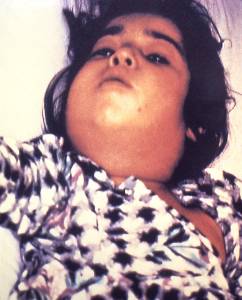Diphtheria is a throat and skin infection that was more common in overcrowded, unsanitary areas and is still common in tropical countries. Incidence and death rates from diphtheria began declining at the turn of the 20th century.
Aids to Public Health (1957), by Llywelyn Roberts, Chief Medical Officer for Sheffield, says:
‘Poverty, overcrowding and poor nutrition are important factors in facilitating the transmission of infectious diseases. Diphtheria was more fatal in the poorer London boroughs because of overcrowding and the lowering of non-specific resistance.’
Also:
‘There was a tendency for diphtheria to decline since the beginning of the century.’
Although the officer attributed the greatest decline to vaccination, he admitted in the same book that:
‘The war of 1939-45 brought home the importance of a sound nutrition and a adequate and well balanced diet has been a major cause of the improving health statistics.’
And:
‘One important, though unforeseen, result of the improvement in our health conditions and standards of nutrition is the greater expectation of life.’
Symptoms of Diphtheria
Symptoms of respiratory diphtheria are:
- Weakness
- Fever
- Sore throat
- Swollen glands in the neck.
In severe cases, the organism that causes diphtheria attacks the tissue at the back of the throat, causing it to die off and create a grey membrane. This membrane can block the airway and make it difficult to breathe.
https://www.cdc.gov/diphtheria/about/symptoms.html
Cutaneous diphtheria (in the skin) has the following symptoms:
- Pus filled spots on the hands, legs and feet
- The spots may then develop into a large ulcer that may scar.
https://www.nhs.uk/conditions/diphtheria/symptoms/#diphtheria-that-affects-the-skin
Treatment of diphtheria is antibiotics and isolation to prevent spread. Vaccinated people can still get diphtheria. Here is a case where a 35 year old vaccinated soldier got diphtheria after cutting himself on a dustbin in Somalia:
Cutaneous Corynebacterium diphtheriae: A traveller’s disease?
A Canadian soldier incurred a nonhealing traumatic skin ulcer while on duty in Somalia. The diagnosis of localized cutaneous diphtheria was confirmed by isolation of a toxigenic strain of Corynebacterium diphtheriae from the ulcer. The patient was placed in isolation and treated with erythromycin and penicillin for 10 days without antitoxin……He was considered fully immunized against diphtheria toxin.
Can J Infect Dis. 1995 May-Jun; 6(3): 150–152.
https://www.ncbi.nlm.nih.gov/pmc/articles/PMC3327909/
 Person with neck swelling due to diphtheria
Person with neck swelling due to diphtheria
